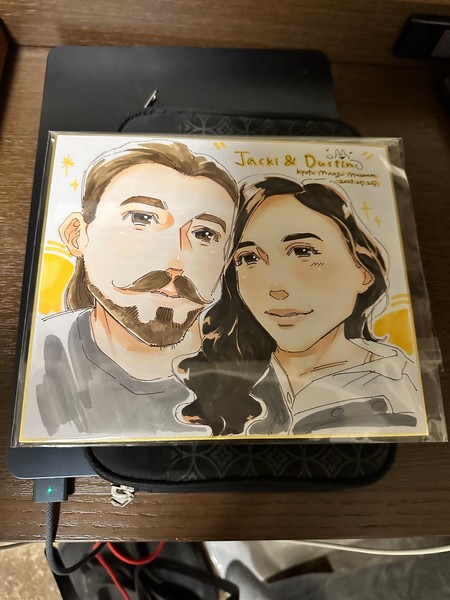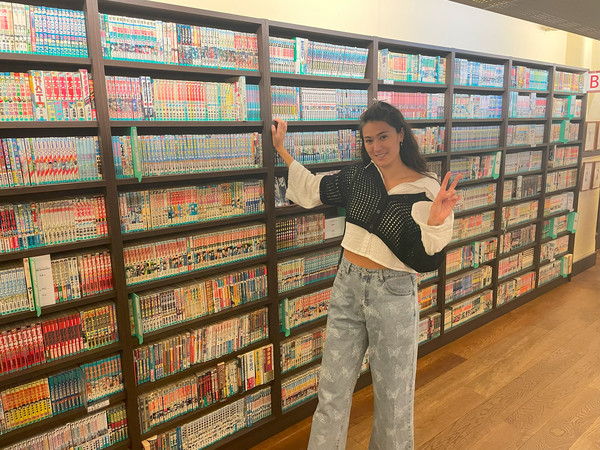Anime Aunties Visit Japan
Day 12 - What to Do at Kyoto International Manga Museum
by Jacki Jing,
I hate to admit this, but many of the museums we've been to have been relatively empty, maybe a couple of people around. Not the case for the Kyoto International Manga Museum. It was packed (on a Thursday, no less). Dozens of people filled the store and lobby, multiple people in each room, eagerly looking at each display. It warmed my heart, and, as expected, it brought in people from all over the world. I heard so many languages within the couple hours we were there, and, incredibly, manga and anime have enriched so many lives that they traveled to Japan just to this museum.
This is an absolute steal for 900 yen ($6.45 USD). It is just a giant library, but I had all this manga at my fingertips, available in various languages- Portuguese, Thai, Catalan, Finnish — and I got to put my hands on the manga and flip through the pages. Nothing feels better.
My partner grabbed Death Note, I grabbed NANA, and we just sat there and read while a woman drew us as manga characters (aren't we cute, she did a great job). And we were surrounded by others reading, sketching, and relaxing. What a perfect day.

After a good read and getting mangafied, we did some deeper exploration. There's just so much — roughly 300,000 items “from caricature woodblock prints of the Edo Period (18th Century) to magazines of the latter half of the 19th century and pre-war time, as well as books ranging from post-war rental books to modern popular series and publications from abroad.”
They have a smaller library of manga in different languages when you walk in. Then there are three floors of nearly every Japanese manga ever created, shelf after shelf. The first floor is for shonen manga volumes. The second floor is for shojo and has The Manga Hall of Fame and other displays about the major manga categories. The third floor is for research conducted by Kyoto City and Kyoto Seika University. There's also a big open courtyard for kids to run around and for people to read (I read there for a little bit too). There's also an art room. It's basically a bibliophile's manga heaven.

I also learned a lot from the Hall of Fame! Here are my biggest takeaways:
- Manga during World War II was mainly used for propaganda, and then after the war, it transitioned to stories.
- Manga magazines are categorized by readers' gender and age group, and there are a lot of categories, from BL to gekiga to shojo.
- It also talked about the importance of panels to mangaka as opposed to comics creators in other parts of the world, claiming that “Japanese manga artists consider the shape of panels, panel layouts and also the arrangement of drawings and words in the panels to control the movement of readers' sight and their reading speed.”
- We love manga for all the expressive faces, but did you know what it's called? Mampu is a “category of symbols that are used especially in manga for expressive purposes… like veins on a person's temple from anger.”
- Manga artists do not make most of their money from serializations in manga magazines since there are a lot of expenses.
The museum broke it down with an incredible visual! Readers buy the magazines, bookstores take a share for selling, distributors take a share for transporting, printers take a share for production, publishers and editors take a share, then divide what's left for each manga artist in the magazine. The manga artist divides those earnings with their assistants. As you can imagine, after that breakdown, magazine publication is “an immense burden” for publishing companies (and, frankly, all involved), and even having manga magazines is being questioned now with the adaptation/exploration of electronic publications.
So where do manga artists make their income? The tankobon editions. When the manga are published as books, “the artists receive 10% of the book sales as royalties which don't have to be shared with other artists. The more they sell, the more profitable it becomes.” Oh, then there's anime, DVDs, merchandise, video games, cinema, and pachinko.
I hope you found all of that as fascinating as I did, and I truly hope you can find your way to the Kyoto International Manga Museum and explore, find your favorite manga, relax, and read. I don't want to go home :( Just a couple of days left in Japan. I am heading back to Tokyo tomorrow.
discuss this in the forum (50 posts) |
back to Anime Aunties Visit Japan
Feature homepage / archives